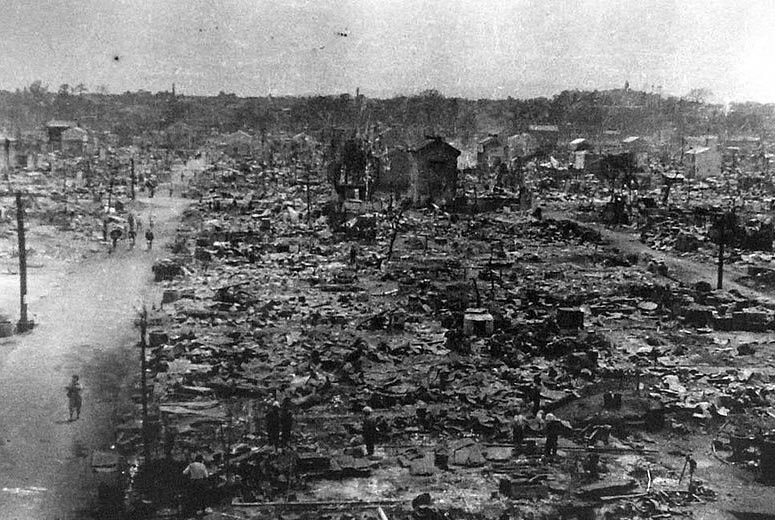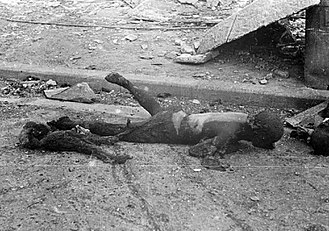Everyone knows about Hiroshima and Nagasaki – two cities where tens of thousands of people were killed by a single bomb – but there is much less awareness about what happened in Tokyo on the night of 9-10 March 1945. Tokyo that night endured the most destructive bombing raid in history, with around 100 000 civilians killed (though no-one knows precisely how many).
 Tokyo after bombing (Inside Story/Wikimedia/Koyo Ishikawa)
Tokyo after bombing (Inside Story/Wikimedia/Koyo Ishikawa)
The Wikipedia account is based on authoritative sources:
On the night of 9–10 March, 1945 (“Operation Meetinghouse”), 334 B-29s [large bombers made by Boeing] took off to raid with 279 of them dropping 1,665 tons of bombs on Tokyo. The bombs were mostly the 500-pound (230 kg) E-46 cluster bomb which released 38 napalm-carrying M-69 incendiary bomblets [napalm is sticky flammable jelly, later used in Korea and Vietnam] at an altitude of 2,000–2,500 ft (610–760 m).
The M-69s punched through thin roofing material or landed on the ground; in either case they ignited 3–5 seconds later, throwing out a jet of flaming napalm globs. A lesser number of M-47 incendiaries was also dropped: the M-47 was a 100-pound (45 kg) jelled-gasoline and white phosphorus bomb which ignited upon impact.
In the first two hours of the raid, 226 of the attacking aircraft unloaded their bombs to overwhelm the city’s fire defenses. The first B-29s to arrive dropped bombs in a large X pattern centered in Tokyo’s densely populated working class district near the docks in both Koto and Chuo city wards on the water; later aircraft simply aimed near this flaming X. The individual fires caused by the bombs joined to create a general conflagration, which would have been classified as a firestorm but for prevailing winds gusting at 17 to 28 mph (27 to 45 km/h).
Following the raid, 16 square miles of central Tokyo had been flattened and a million people were homeless.
There is more about the bombing in this 2012 note by Daniel Russ on a military intelligence blog, Alex Wellerstein’s comparison between Hiroshima and Tokyo, this article by the ABC’s Matthew Carney to mark the 70th anniversary, David Hayes in Inside Story for the 70th anniversary, and this 2016 piece by Senan Fox in The Diplomat. Fox quotes a report by the US Strategic Bombing Survey:
[P]robably more persons lost their lives by fire in Tokyo in a 6-hour period than at any time in the history of man. People died from extreme heat, from oxygen deficiency, from carbon monoxide asphyxiation, from being trampled beneath the feet of stampeding crowds, and from drowning. The largest number of victims were the most vulnerable: women, children and the elderly.
Curtis LeMay, United States Air Force general who masterminded the Tokyo bombing (and who played similar roles in many other Japanese cities, Korea and Vietnam), famously said that his planes ‘scorched and boiled and baked to death more people in Tokyo on that night … than Hiroshima and Nagasaki combined’. Robert McNamara, later US Secretary of Defense but on LeMay’s staff in 1945, recalled in 2003 LeMay’s view that,
“If we’d lost the war, we’d all have been prosecuted as war criminals.” And I think he’s right [McNamara went on]. He, and I’d say I, were behaving as war criminals. LeMay recognized that what he was doing would be thought immoral if his side had lost. But what makes it immoral if you lose and not immoral if you win?
(In the You Tube extract, from The Fog of War, McNamara also addresses the choices that need to be made during war.)
We checked to see if the Australian War Memorial was marking the Tokyo anniversary. The Memorial’s website shows that the highlight tomorrow (apart from continuing exhibitions and the daily Last Post ceremony) is its regular ‘Story time: free activity for kids’ at 10.30 am.
Hear the stories of brave animals, extraordinary people and faraway places brought to life through puppets, uniforms, and educational toys. This program is suitable for pre-schoolers, but older brothers and sisters are also welcome.
 Mother and child after Tokyo bombing (Wikipedia)
Mother and child after Tokyo bombing (Wikipedia)
Every country is parochial about commemoration but Australia seems to be more parochial – and myopic – than most. There is, however, a connection of sorts between Tokyo 1945 and the Memorial today: Boeing, the maker of those 334 B-29s, is one of the Memorial’s major donors – Director Brendan Nelson told Senate Estimates in February 2015 that the Memorial had received $1 million from Boeing in the year 2014-15 – and its CEO, Dennis Muilenburg, is one of just two businessmen who are Fellows of the Memorial.
8 March 2018